Experiences with HP9000 series 200 workstations
HP 9000/217 with HP7957B and HP9122
The HP 9000/217, also known as the HP9817 was a workstation computer built by Hewlett-Packard between 1984-1985. This computer was based on a Motorola 68010 microprocessor and can be used with the HP-UX operating system or with HP BASIC. In this page, I show some pictures of my system. Figure 1 shows the central unit, already cleaned, with the monitor.
Fig.1: The central unit and the screen.
Figure 2 shows the boot screen. The operating system is not loaded since nothing is connected to the GPIB bus and the central unit does not have any mass storage device.
Fig.2: The boot screen.
Figure 3 depicts the view I had when I opened the HP7957B hard disk. There was a considerable amount of dust due to the years of service. The disk itself was so big that there was a small fan on the same motor which made the plates turn, just above the control electronics board (this fan is not visible on the picture).
Fig.3: Inside the impressive HP7957B, a 81 MiB hard disk.
The hard disk unit after a delicate but complete cleanup is shown in figure 4.
Fig.4: The inside of the hard disk after cleaning all the dust.
Figure 5 shows another point of view on the system, which was heavy and quite rugged thanks to the metal sheets everywhere. We can appreciate the size of the disk drive unit, compared with the screwdriver:
Fig.5: Another view of the hard disk.
The GPIB control card in place is shown in figure 6. The connector is visible on the backside of the unit.
Fig.6: The GPIB card.
Figure 7 depicts the complete system, with the HP7957B as well as the disk driver HP9122. Unfortunately, one of the two disk drivers of the HP9122 is not working. I discovered the hard way how much the heads are fragile and I jammed them by inserting a disk in a partially disassembled drive. Anyone has a spare SONY OA-D32W-10 disk driver?
Fig.7: A view of the complete system.
The dusty inside of the HP9122 is shown in figure 8.
Fig.8: Inside the double disk driver HP9122.
Thanks to the kind help of Jürgen Keller, I could boot the machine with HP-BASIC at the beginning of 2016 and I could therefore tinker a little with this machine. For the moment being, I have not yet used it a lot, but things may change soon, as I could find her smaller sister, the HP9000/216 also known as HP9816.

Fig.9: The HP9000/217 with the HP-BASIC 5.1 boot screen.
HP9000/216 with HP9122
At the beginning of 2018, I could save another HP workstation, a HP9000/216, also known as 9816. It is a very small machine first put on the market in 1982, all self contained in the monochrome monitor case (but without any mass-storage device that has to be external), and based on the Motorola 68000 processor. I could use it with the same HP9122 that I used also for the 9000/217 described above. After a few adventures, among which a blown X-rated filter capacitor in the power supply module (figure 10), I could power it up and use for a certain amount of time, with great pleasure, as shown in figure 11.
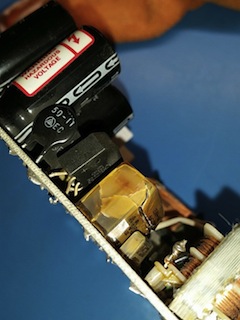
Fig.10: The blown X-rated filter capacitor in the power supply.

Fig.11: The HP9000/216 aka HP9816 with all her gorgeous beauty.
I then decided to try to do something useful for me and I decided to translate in HP-BASIC the code for performing third-of-octave spectral analysis I wrote in C for modern computers. This code controls a Brüel&Kjaer 2034 FFT spectrum analyzer that can be controlled with GPIB. Such an analysis is shown in figure 12.
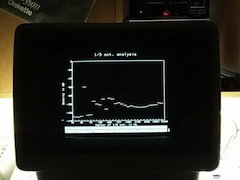
Fig.12: The result of a third of octave analysis. This plot can be easily plotted on paper with a HP7470A plotter.
If you are interested, I put the HP-BASIC source code on GitHub, GPL v.3.0.
I used many BASIC dialects in the past, most of them related to the classic Microsoft interpreter (VIC-20, C64, C128, Olivetti M20, QuickBasic, VisualBasic 3.0 etc...), but this was my first contact with the HP-BASIC. Well, it is gorgeous. It is an instrument built by engineers for engineers, with the declared purpose to be very effective to control measurement instruments. Even the editing capabilities are quite advanced for a machine built in 1982.
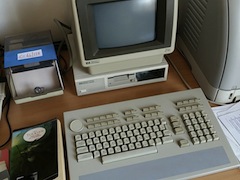
Fig.13: The HP9000/216 with a HP9122 with a single drive and the huge HP98203B keyboard, nicknamed "Nimitz", still not attached to the computer.
We may say something about the excellent mechanical keyboard HP98203B, nicknamed Nimitz because of it respectable size. Figure 13 shows how the keyboard size is impressive, if compared with the very small footprint of the computer. I could use it a bit and it is very effective and allows to type in a very confortable position of the hands. I do not know if the feeling is comparable to the well known IBM Model M (I used it so many years ago and I can not compare to the HP keyboard), but the touch is excellent to my taste, well superior to the membrane keyboard of the laptop computer on which I am typing this text. Maybe I can criticize that the cursor movement keys are not disposed as a cross. This is compensated by the knob that moves horizontally the cursor if rotated alone, or vertically if rotated while holding the Shift key.
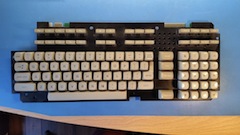
Fig.14: Inside the keyboard, still quite dirty.
Figures 14, 15 and 16 show how I cleaned my keyboard. I had to do that as there was a lot of dust left by the years.
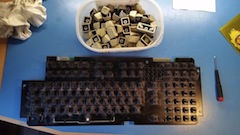
Fig.15: Disassembling keys.
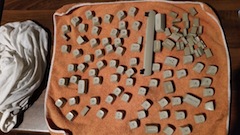
Fig.16: Drying the keys.
I also savaged the HP9134XV, a big module containing a 14.5MB hard disk that I cleaned. Once opened, it revealed a big quantity of dust that I removed throughly. I also found that the jumper configuration was for a 10MB disk and not for a bigger size. After a few tryouts, I could manage to format the drive and to load the HP-BASIC 5.1 as well as my spectrum analysis program. The hard disk spins with a very characteristic noise that I tried to record in Video 1.
Video.1: A HP9134XV hard drive module, cleaned and used to boot a HP9000/216 workstation. The characteristic noise of the disk is quite loud, especially if compared with modern machines, very often quite silent.
Log
September 23, 2012: first version of the page, dedicated to the HP9000/217.
January 28, 2018: Added a picture of the 217 boot with HP-BASIC 5.1, added description of the 9000/216 computer with pictures and link to GitHub. Global review of the whole article.
January 30, 2018: Added the description of the HP98203B keyboard with pictures.
February 3, 2018: Added the video of the HP9134XV disk booting the HP9816.
